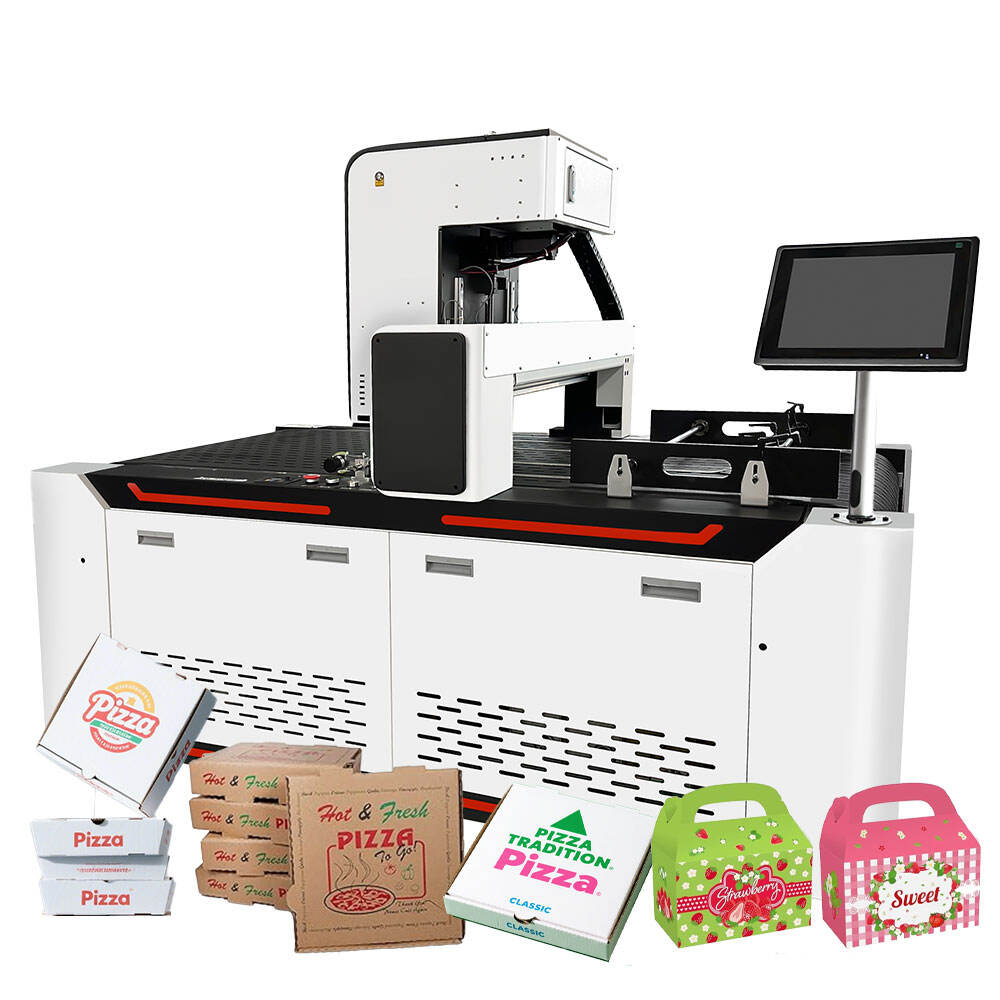When pizza shops face the dual challenges of packaging labeling efficiency and cost, traditional printers often fall into the dilemma of "slow speed, poor quality, and expensive consumables". The industrial-grade single-pass digital printer based on EPSON A3 + print head is reconstructing the pizza box printing standard with disruptive technology, surpassing the traditional solution in terms of speed, cost, and quality, and becoming the first choice for pizza chain brands and small and medium-sized stores to upgrade.
1. 48 meters/minute ultra-high-speed printing: subverting the traditional efficiency boundary
Peers mentioned that "printer speed affects service experience", but did not give specific data. The single-pass technology achieves an industrial-grade speed of 48 meters/minute (traditional equipment is only 15 meters/minute). Taking a 12-inch pizza box as an example, a single device can print 20,000 per day, which is equivalent to the production capacity of 3 traditional printers. After a chain pizza brand was introduced, the packaging preparation time during peak hours was shortened from 20 minutes to 5 minutes, the back kitchen efficiency was increased by 75%, and the full process of "order, print, and install" was accelerated, and the average customer waiting time was reduced by 12 minutes.
The speed advantage comes from the single-pass nozzle array technology: 1-3 groups of EPSON A3 + print heads work in parallel, and complete CMYK full-color printing in one pass, which is 3 times more efficient than traditional reciprocating printing. With the self-developed intelligent control system, it can synchronize order system data in real time, automatically call box templates of different sizes, and avoid time-consuming mistakes caused by manual parameter switching.
2. 1600DPI ultra-clear image quality: a visual leap from packaging to brand
Peers emphasize that "printing quality affects customer experience", but lack technical support. The device achieves photo-level printing with a resolution of 1200*1600DPI, and can accurately restore close-ups of pizza fillings, gradient colors of brand LOGO, and microtext of the nutritional table. Comparative tests show that on pizza boxes printed by 300dpi traditional equipment, the LOGO edge jagged rate reaches 18%, while the jagged rate of 1600DPI equipment is less than 3%, and the visual delicacy is improved by 6 times.
The core advantage lies in the micro-piezoelectric technology of EPSON industrial-grade nozzles: the minimum ink droplet reaches 3.5pl (picolitres), which is equivalent to 1/20 of the diameter of a hair, and can achieve smooth transitions on rough surfaces such as corrugated paper and kraft paper. A high-end pizza brand uses this feature to print hand-painted illustrations of ingredients on the box body, which has increased the customer's photo sharing rate by 40%, driving a 22% increase in online orders.
3. Single box cost $0.035: Redefining input-output ratio
Peers mentioned "reducing waste and saving money", but did not quantify the cost. The device uses 1 liter of ink to print 60,000-70,000 A4 sheets (5% coverage) with ultra-low consumables consumption, reducing the printing cost of a single pizza box to $0.035 (traditional equipment requires $0.12). Calculated based on printing 20,000 boxes per day, the annual consumables cost can save $65,000, and the equipment investment can be recovered within 8 months just from the ink cost.
The cost advantage also comes from the zero-plate-making fee design: traditional printing requires the production of film plates (single plate costs about $500), while digital printing directly connects to design files, supports real-time modification of patterns, and avoids inventory backlogs. After optimization, a regional pizza chain reduced packaging inventory costs by 60%, and achieved flexible production of holiday limited editions and member-customized boxes.
IV. Intelligent Technology Matrix: Industrial-grade Durability and Flexibility
· Self-developed motherboard: integrated remote upgrade function, which can push firmware updates through the cloud to solve the problem of "hardware obsolescence" of traditional equipment, and extend the equipment life cycle to more than 5 years.
· Full-scene adaptability: The nozzle height is adjustable from 0 to 200mm, compatible with 12-inch standard boxes and 4-layer thick corrugated boxes, and with waterproof pigment ink, it will not smudge even in the presence of condensed water, meeting the needs of takeaway scenarios.
· Environmental compliance: Water-based ink has passed SGS food contact certification, has no VOC emissions, and is more in line with EU environmental standards than solvent-based inks, helping brands obtain green certification.
5. Full-link service guarantee: worry-free experience from installation to operation and maintenance
Peers did not mention after-sales support, but this device provides 2-year whole machine warranty (excluding print head) + lifetime technical support. Engineers can diagnose faults through the remote system, and the average response time is < 15 minutes. The global 1000+ installation cases show that the average trouble-free operation time of the equipment is 8000 hours, which is 50% higher than similar products.
An Australian pizza brand user feedback: "It only took 4 weeks from ordering to installation. The engineer came to the door for 3 hours of training to master all functions. When the ink ran out, the system automatically reminded to purchase, which did not affect production at all."
Conclusion: Make packaging the engine of brand growth
When the pizza industry enters the era of "visual is traffic", packaging is no longer a simple container, but a key touchpoint for brand communication. The industrial-grade single-pass digital printer, with its three-dimensional advantages of "high speed + high definition + low cost", not only solves the pain points of efficiency and cost, but also activates brand communication through customized visual design. For a pizza shop that receives more than 500 orders per day, this device can generate more than $900,000 in additional profits each year, truly realizing the value leap of "one printer driving business growth."

 EN
EN
 AR
AR
 HR
HR
 NL
NL
 FR
FR
 DE
DE
 IT
IT
 JA
JA
 KO
KO
 PL
PL
 PT
PT
 RO
RO
 RU
RU
 ES
ES
 SV
SV
 ID
ID
 TH
TH
 TR
TR
